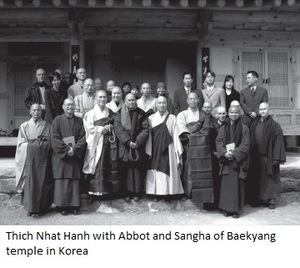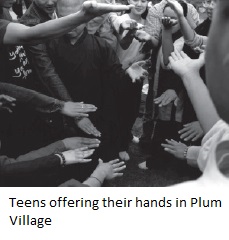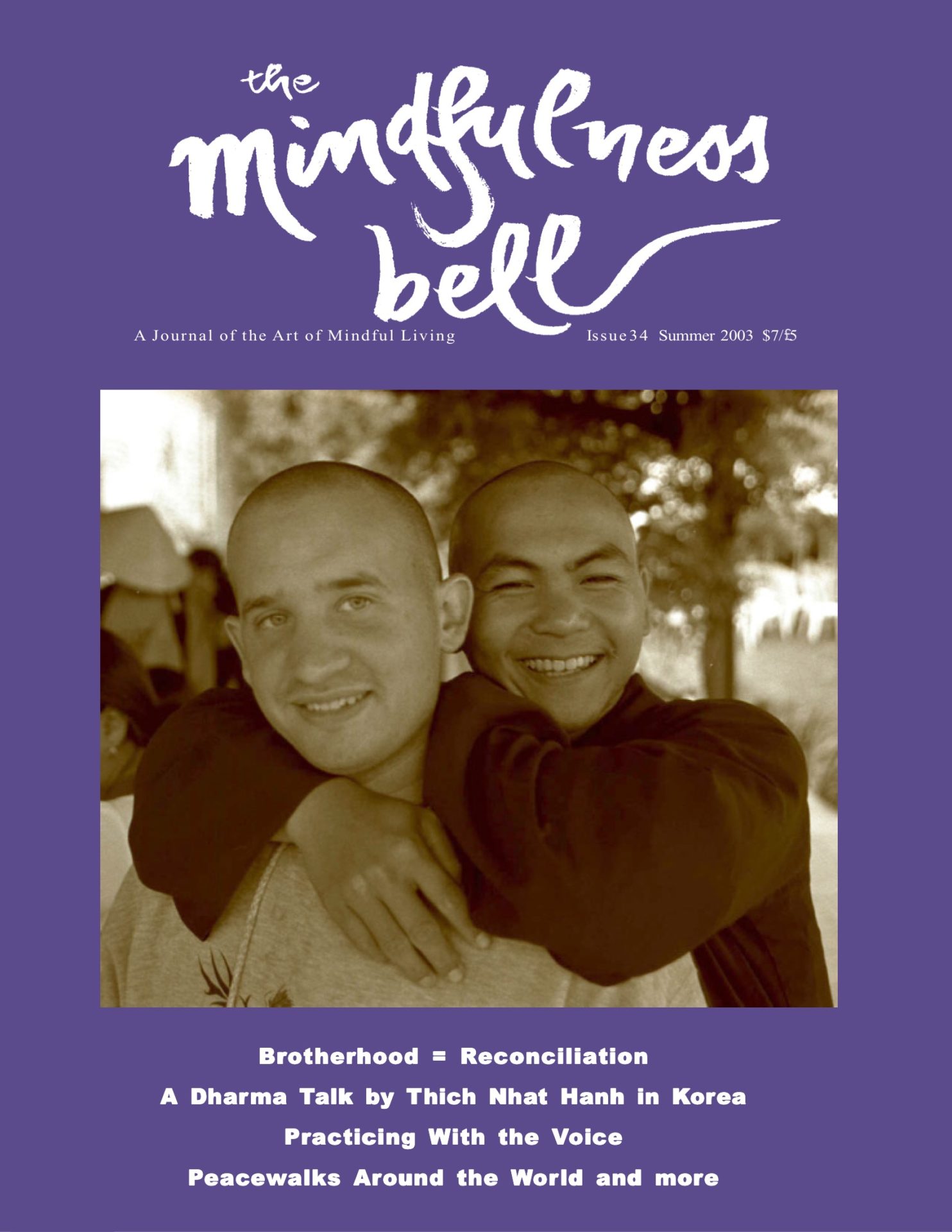By Thich Nhat Hanh
From a Dharma Talk at Joongang Sangha University for monks and nuns in Kimpo, Korea on March 31st, 2003

My dear friends, according to my experience the study of Buddhism and the practice of Buddhism should always go together. It is not possible to learn the teachings first and then begin to practice because it is by practicing that we understand the teachings,
By Thich Nhat Hanh
From a Dharma Talk at Joongang Sangha University for monks and nuns in Kimpo, Korea on March 31st, 2003

My dear friends, according to my experience the study of Buddhism and the practice of Buddhism should always go together. It is not possible to learn the teachings first and then begin to practice because it is by practicing that we understand the teachings, not just by listening and studying. We might think that we have understood the Heart Sutra but then ten years later we realize that we did not. Thanks to our practice, thanks to confrontation with difficulties and suffering we begin to really understand. Suffering plays a very important role in helping us to understand the teachings of the Buddha. Thirty years of war in Vietnam have helped me to understand Buddhism more profoundly.
When I was a young novice learning about the three refuges and the five precepts I thought that I understood them. But now I see that my understanding was very superficial. My understanding of taking refuge in the Buddha has been evolving through the years. After sixty years I continue to see more deeply into the practice of taking refuge. Taking refuge in the Buddha is something you practice all day long. You can take refuge in the Buddha while sitting, while walking, or while cooking for the community. Taking refuge in the Buddha brings me a lot of happiness. Learning the teaching and putting the teaching into practice in such a way that you can be nourished by it brings joy. It is that joy that enables you to continue your life as a monk or as a nun.
Suffering and Happiness of Monastic Life
In your monastic life sometimes you encounter a lot of difficulties, a lot of suffering, and you might be tempted to give up your life as a monk or as a nun. If there is no joy in the practice then you will certainly give up your monastic life. Sometimes the relationship between you and your teachers and the relationship between you and your Dharma brothers or sisters becomes difficult and you are discouraged. You don’t see any joy in the Sangha. You feel that nobody in the Sangha understands you, not only your brothers in the Dharma but also your teacher. People around you seem to practice very hard but they have not transformed, they are still angry, they still have many prejudices. And you lose faith in the practice. Many high monks speak about non-self but they are full of self and they are seeking fame, wealth, and power, and that is why you are discouraged and you want to give up. I realize that when you don’t find happiness in the Sangha and in your life as a monk or a nun you could be tempted by things in the world like fame, like wealth, like sex. But if there is joy and happiness in your daily life as a monk or a nun then these temptations would not be important at all.
Tempted by Communism
As a young monk there was a time when I was tempted to become a communist. I saw that in the Buddhist community people talked a lot about serving living beings but they didn’t have any practical methods to help the country, which was under foreign rule and the people, who suffered from poverty and social injustice. As a young monk I wanted Buddhism to respond to the situations that created suffering and to help reduce the social injustice and political suppression. Many elders spoke about serving living beings but they did not give the kind of teaching and practice that could relieve the suffering in society. I saw that the communists were really trying to do something and they were ready to die for the sake of humanity. So temptation at that time for me was not fame, not money, not beautiful women – it was communism. I did not become a communist because I was very lucky. I realized quickly that being a member of the communist party, I would have to obey the orders of the party and may have to kill my countrymen who did not agree with the party, instead of being able to serve them.
As a young man or a young woman you are full of good intentions to serve the people of your country, so you become a member of a political party. You want to serve, not to harm people, but your party may become like a machine and one day you may be given the order to kill, to liquidate other young people who do not belong to your party and you have to betray your first intention to love and to serve. I was saved by the enlightenment that violent revolution was not my path. I did not want to go in the direction of violence. As a young man or a young woman, when you enter monastic life you are determined to serve the people in your society and other living beings. You are a revolutionary. Leaving your family behind, shaving your head, putting on a monk’s robe is an act of revolution. You want to be like Siddhartha, offering your life in order to relieve the suffering of living beings. But if the teaching and the practices that you are given do not satisfy that desire to serve and to help others, then you will be disappointed.
Engaged Buddhism
After several years being in the Buddhist Institute1 my need was not satisfied, so I left. Also there was division in the community, there was no harmony, and people did not really do what they taught. I did not give up the life of a monk, however, because deep in me there was a strong belief that Buddhism could be renewed and could offer the teaching and the practice that would respond to the actual suffering in the world. I thought of engaged Buddhism, the kind of Buddhism that can be applied in all walks of life, in the realms of education, economics, technology, science, politics, the arts, and so on. I knew that historically Buddhist teachers guided and advised the political leaders. But nowadays business and political leaders do not listen, and it seems we have lost our spiritual leadership. At this time I was only a monk of twenty-four years old, just fully ordained, but I had a deep conviction that spiritual leadership could be restored to Buddhism and that Buddhism could give guidance in all areas of society.
With a number of other young monks we created a community of practice and tried to form a way of practice which we called “Engaged Buddhism.”

Buddhism must be present as a spiritual dimension in all aspects of life. In 1954 when Vietnam was divided into two countries, North and South, the suffering was intense. I was given the chance to realize a reform of the teaching and the practice in the Buddhist Institute in the South of Vietnam, called the An Quang Institute. I called on young monks and young nuns and together we created a system of education and practice that had the capacity to respond to the difficult situation in the country and in the world. At twenty-eight, I had to take care of reorganizing the largest Buddhist Institute in South Vietnam. I was lucky to have the love and support of the young monks and nuns, and together we tried to renew the teachings and the practice. We also had a number of elders who supported us and believed that we could do it, which was crucial for our success. At that time the French army had just been defeated in the North by the communist army and the French soldiers were leaving the country and American advisors began to arrive. It was the intention of the Americans to replace the French and to retain the South as a stronghold in order to contain communism and not allow it to spread in Southeast Asia. The country was divided and people suffered not only from social injustice and political oppression, but also from doubt and anger. We felt that Buddhism should do something to show people that there is a path leading us out of this difficult situation, and to create peace, brotherhood, and reunification.
It was suffering that helped us to give birth to what today we call “Engaged Buddhism.” Now this expression has become popular in Europe and America and there are Buddhist communities and associations that use it, like the Buddhist Peace Fellowship. There are now Buddhist groups that organize soup kitchens for hungry people, centers to help dying people, and so on. Plum Village is now helping hungry children, disabled people, and refugees in Vietnam. Engaged work in society has become part of our daily practice.
Happiness and Harmony in the Sangha
Every one of us wants to help our society, but in order to go far we have to operate not as individuals but as a Sangha. If there is no harmony in the Sangha, if there is no brotherhood in the Sangha, if there is no happiness in the Sangha we do not feel nourished and we will not be successful. That is why the teaching and the practice of Buddhism should be effective in Sangha building. If the practice of Buddhism does not help the Sangha to be more harmonious, does not help brotherhood to grow, does not help to create more happiness in the Sangha then that practice is not effective and we don’t want it. You can practice very hard, staying up all night in the sitting position and not sleeping at all, but if there is no joy, no compassion, no understanding in you and the Sangha is divided and unhappy, then your practice is not correct. We should practice every day in such a way that happiness can grow in our Sangha. If there is no harmony, no happiness in the Sangha, serving living beings is an illusion.

We may like to sit together and ask whether there is happiness and harmony in our Sangha. If there is no harmony and no happiness in the Sangha what are the reasons? What are the causes? What can I do in order to make the Sangha suffer less? What can I do to make the Sangha happy today? Together as a Sangha we practice looking deeply into the first Noble Truth, namely the presence of suffering, the absence of happiness, in order to find out the second Noble Truth, the roots and causes of our unhappiness. To me a Buddhist Institute should be organized as a family, where everyone is a brother or a sister for everyone else. Our daily practice should be centered on building brotherhood and sisterhood. If we are nourished every day by the happiness of brotherhood or sisterhood we would never give up our life as a monk or a nun. Of course, we have to study the sutras, the shastras, and the vinaya.2 But we have to study in such a way that we can find ways of practice that will build a happy Sangha. Sangha building is our daily practice.
Many of us are capable of building big temples, but not many of us can build a happy Sangha. That is why I have been proposing that in Buddhist Institutes Sangha building become an important subject of our study and practice. If there is no real happiness, brotherhood, and harmony in the Sangha and we go out to teach the practice, we are offering fake products. In the Buddhist Institutes, Dharma teachers should not only teach what they know but should teach with their way of life. We should not be overwhelmed with texts. We should have time to look deeply into each member of the Sangha to see the suffering and difficulties of each person and to offer our help. In that way we can go together like a river, in the direction of enlightenment, transformation, and service.
During the twenty years of sharing Dharma in the West we have learned a lot about Sangha building and we have learned a lot about offering the kind of teaching that helps in modern times. I can tell you as an elder brother that the noblest task is to build a happy Sangha. The Sangha is like a beautiful garden. You have to take care of each tree and bush in the garden. You have to understand the nature and the need of each tree and bush. You take a lot of time to help each member of the Sangha grow beautifully and happily. When the garden grows beautifully, you enjoy it a lot; when the Sangha is happy, you are well rewarded with happiness. When people come and visit the Sangha and they see the harmony and happiness, they will have faith in the Dharma. We don’t have to say anything; they just look at the Sangha and they have faith.
One day the King of Sravasti, King Pasenadi, met the Buddha. They were both eighty years old. The King said, Lord Buddha, every time I see your Sangha I have faith in the teachings. The Buddha did not build any temples but he was an excellent Sangha builder. We, his students, monks and nuns and laypeople, should not only spend our life building temples, we should devote our time to building happy Sanghas.
(Endnotes)
- The Buddhist Institute is the place where young monastics are sent to study sutras, ancient languages and other Buddhist Young monastics come from many different temples to study together and are generally awarded a degree at the end of their studies. This form of training is followed in most Mahayana Buddhist countries including China, Vietnam, and Korea.
- The sutras are the teachings given by the Buddha, the shastras are commentaries on these teachings and the vinaya is the collection of rules and regulations governing the monastic Together these three collections of Buddhist scripture are referred to as the tripitaka, or the three baskets of Buddhism scripture.

